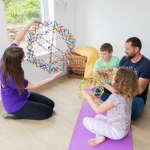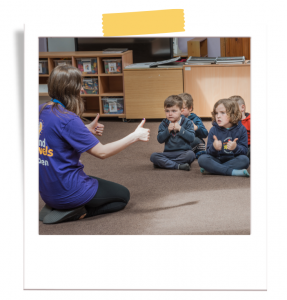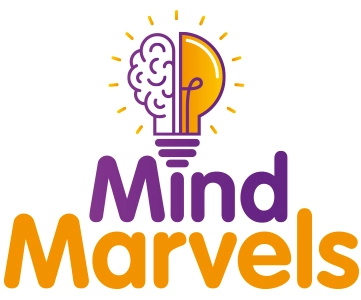
Family wellbeing: practical tips to make winter easier
November 18, 2024
The many types of kindness: Helping children grow with empathy
February 21, 2025Education around children’s human rights from an early age is an empowering tool for any child.
Children can recognise their rights, but it also allows them to grow a sense of empathy for others and, indeed, a sense of justice.
Talking about our human rights doesn’t have to be reserved for those who hold power within our society – everyone should discuss it, as it fundamentally affects all of us.
Children have direct knowledge of how issues affect them and other children around them; they have ideas and opinions that should be given the opportunity to be shared.
These discussions are rich in learning for both adults and children. It’s a great way to get across that all views and ideas are valid, no matter how trivial they may appear, but talking about feelings and emotions allows the conversations to deepen.
Ultimately, it encourages us all to be more open to new ideas! During our Mind Marvels sessions, we teach kids to ‘be kind’ and encourage positive thinking, and we can instantly see how this opens up their minds.
Help children appreciate the beauty of diversity by exploring various cultures and traditions.
With that in mind, here are five practical ways to help children understand and support human rights:
1. Encourage open dialogue about fairness and equality
Begin by discussing everyday concepts of fairness and equality, relating these to situations they encounter. Ask questions like, “How would you feel if you weren’t allowed to play with a toy?” or “What if only some people were allowed to speak?” These questions help children connect personal experiences with larger human rights concepts.
Activity idea: Check-in
What you need: A series of colourful shapes that represent a range of emotions.
Ask each person to choose an image or shape representing their feelings. One by one, everyone shares their choice and explains why they are feeling that way. A verbal check-in is also an option, where the adult might start a sentence such as:
- “When I arrived today, I felt… because…”
- “As I sit in the circle, I feel… because…”
- “I’m feeling… about the session today because…”
The main goal of the check-in is to create a safe space for children to express their emotions openly. Emphasising that all feelings are valid, this activity reminds children that there are no ‘right’ or ‘wrong’ emotions.
2. Use stories and books about diversity and justice
Books and stories can introduce children to diverse perspectives and historical struggles for human rights. Choose age-appropriate stories that cover themes of diversity, resilience, and justice, allowing children to see the impact of human rights on real people’s lives.
Activity idea: Interactive storytelling about children’s human rights
What you need: Lots of paper, and pens (to have the option to write and draw out the story).
Explain that everyone has rights—things that help us feel safe, respected, and happy. Introduce examples like the right to play, the right to learn, and the right to be heard.
Start by describing an imaginary world where children have superpowers that help protect the rights of everyone around them. The children in this story work together to solve challenges, like ensuring their friends are included in games or making sure everyone has enough to eat.
Let the children create their characters in the story, each with a unique “power” that helps protect a different right. Examples could include:
- Kindness beam: Helps others feel included and safe.
- Learning spark: Make sure everyone has a chance to learn and grow.
- Laughter lift: Brings joy and reduces worries for those feeling sad.
Guide the story, presenting challenges that the children, as their characters, can solve using their powers. End the story by celebrating how the characters protected everyone’s rights. Briefly discuss each child’s “power” and how it contributed to the group’s happiness and wellbeing.

3. Celebrate different cultures and traditions
Help children appreciate the beauty of diversity by exploring various cultures and traditions. This can be done through festivals, food, music, or traditional crafts. Experiencing other cultures builds an understanding of everyone’s right to celebrate and express their heritage.
Activity idea: Cultural passport adventure
What you need: Small notebooks or sheets of paper for each child (to create a “passport”), stickers or stamps (to mark each “visit”) and storybooks, props (clothes, instruments, food etc) and simple descriptions about each culture’s traditions
Give each child a “passport” to collect stickers or stamps as they “visit” different cultures. Set up several “cultural stations” around the room, each dedicated to a different culture or tradition (for example, Mexico, India, China, Nigeria, Scotland). Include visuals, simple descriptions, and interactive items like clothes or toys.
Let children explore each station. Encourage them to try on clothes, listen to music, look at books, sample simple snacks if allowed, and stamp their passport.
At the end, gather the group and let each child share something new or interesting they learned about a culture.
4. Encourage acts of kindness and empathy
Inspire children to perform acts of kindness in their everyday lives. Simple gestures, like helping a friend in need or standing up for someone being treated unfairly, reinforce the idea that everyone deserves kindness and respect. Discuss the value of compassion and how small actions can support the rights of others.
Activity Idea: Kindness Quest
What you need: “Kindness Cards” with simple acts of kindness written on them, stickers or stamps, paper to make a chart and small rewards (i.e. stickers).
Firstly, create a chart or poster where children can track completed acts of kindness with stickers or stamps. Show children a selection of kindness cards. Each card has a simple, child-friendly act of kindness they can do for friends, family, or teachers.
Each child picks one or two cards as their “kindness quest” for the day. For younger children, you can help them choose. Encourage children to complete their kindness quests throughout the day. As they finish each task, they get to add a sticker or stamp to their spot on the kindness chart.
At the end of the day, let children share how they completed their quests, who they helped, or how it made them feel. Give out small certificates or stickers as a fun reward for each child’s efforts, and encourage them to keep doing kind things daily.
5. Introduce age-appropriate volunteer activities
Encourage children to participate in activities in their community, such as helping at a local shelter or environmental clean-up. These experiences teach them the importance of contributing positively to society and show how communities work together to uphold the rights of all members.
Activity idea: Helping hands in the community
What you need: Large poster board or whiteboard to create a “Helping Hands Wall, paper hand cutouts for each child, markers, crayons, stickers and pictures or simple descriptions of different volunteer activities.
Start by explaining to children what it means to volunteer, using simple examples such as planting flowers or picking up litter. Then think about what you could do in your local community.
Give each child a paper hand cutout and ask them to write (or draw) one volunteer activity they’d like to try or have enjoyed before. Attach these to the “Helping Hands Wall” as a display. Then they can do these simple acts of volunteering – whether it’s planting flowers in pots or making a kindness card for someone in a care home.
After the activity, ask the children how it felt to help others. Encourage them to share who they think their act of kindness might help and why it’s important.
By connecting these ideas to children’s everyday lives, you provide them with a strong foundation in human rights principles and encourage a lifelong appreciation for justice and equality.
During our sessions at Mind Marvels, we encourage kids to think positively, be kind, and recognise the value in each individual’s rights and perspectives. We hope we can inspire the next generation of compassionate changemakers!
